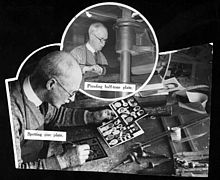Conclusion: Photographic Technologies
 Enlarge
Enlarge
The success of Spencer’s History of the United States suggested that in the decades after the Civil War, the genre of pictorial history had entered a “golden age” of sorts, when illustrated formats dominated nearly every type of print media. There were a number of compelling reasons why the genre continued to grow during this period.
First, the abilities of publishers to reproduce images in illustrated texts continued to improve due to the successful application of photographic technologies to the printed page. The development of the “photograph-on-the-block” in the 1880s, for instance, allowed highly complex paintings and drawings to be translated to the printed page without the intermediary of an engraver. [Image 57] The halftone employed a grid that acted as a screen between the lens of a copy camera and a photosensitive copper plate coated in a light-sensitive gelatin film. When a photograph was taken through the grid, a series of small dots was imprinted on the plate that was bathed in acid, resulting in an etched surface in negative relief that could be inked to produce a positive image. This technique allowed publishers to replicate almost any visual image they desired without experiencing the problems of textual differentiation and modeling that had long plagued engravers. [90]
Pictorial histories became more unrestrained and experimental in style as a result of these advances, reproducing in their pages “the subtle chiaroscuro of oil paintings, or the crisp washes of watercolor, or the chalky freedom of crayon drawings.” [91] This was a sad development for engravers, of course, who since the days of William Croome had played a crucial role in the pictorial process. But the advantages of the halftone process were so substantial to the freeing up of the illustrator or reducing of costs to the publisher that this loss was easily rationalized. Photography seemed to settle the issue of how to pictorialize history sufficiently without compromising a commitment to accuracy and realistic detail.
Second, and perhaps more important for the durability of pictorial history as a genre, was the development of techniques for colorizing illustrations that increased dramatically the visual impact of pictures in books. Advances in chromolithography (in which individual colors were printed from separate lithographic stones) and later in color halftone processes (in which a “color-record negative” was used to translate pigments to the printed page) improved the effectiveness of colorized illustrations. Eventually bookmakers perfected duotone relief plates to produce three-color halftone blocks for illustrations that revolutionized the way readers received visual impressions. Because color images still required special paper for printing and had to be “tipped in” to a book on separate insert pages, black-and-white drawings continued to dominate in-text representations, but most major pictorial histories of the 1890s advertised “chromos” as the most salient feature of their visual packaging. [92]
